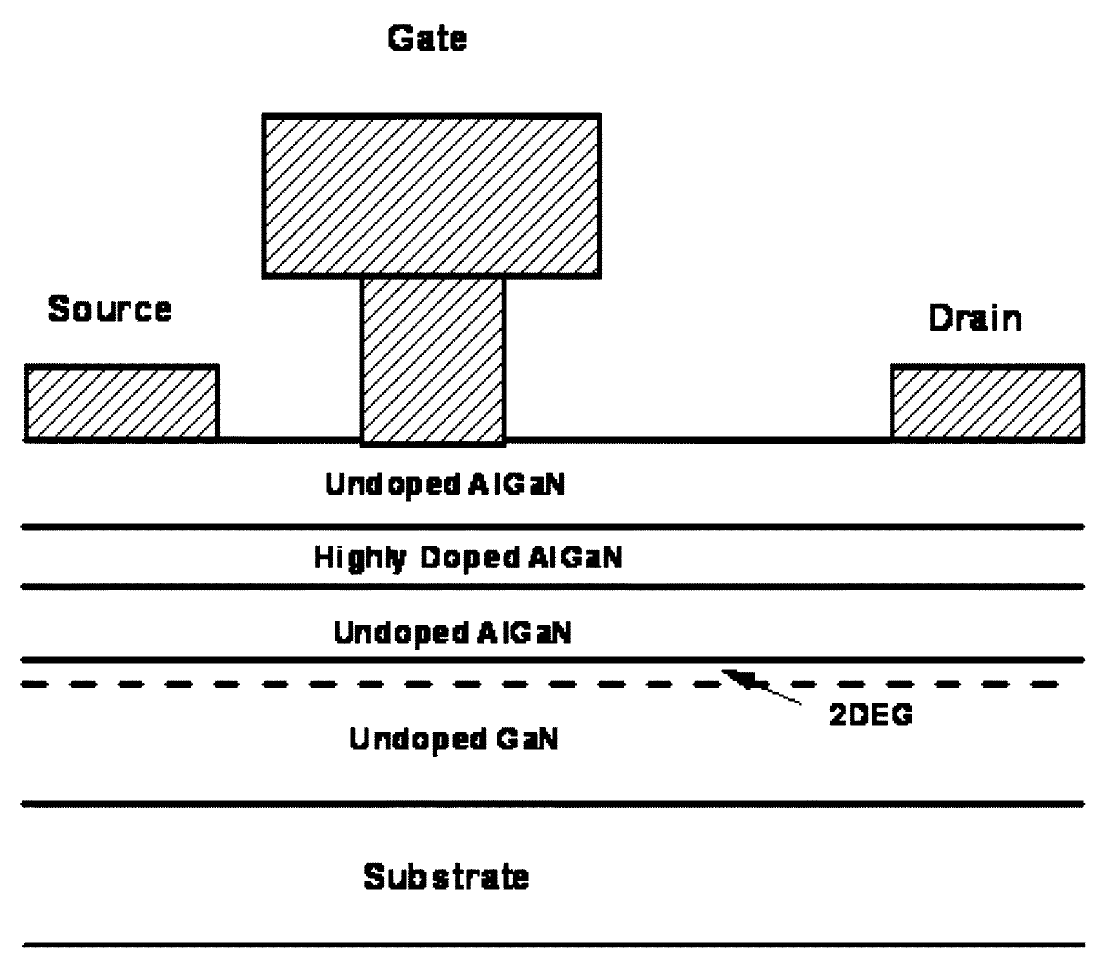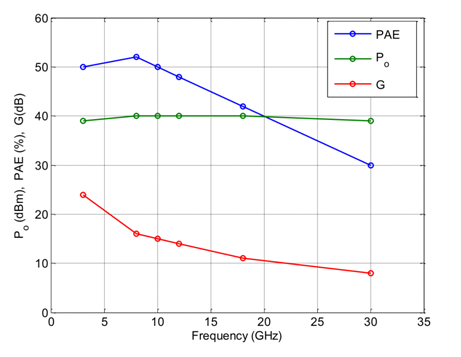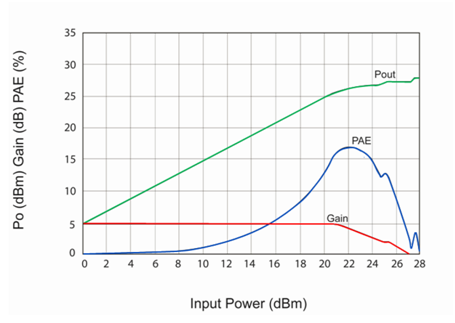 4 Electrical properties of HEMT
4 Electrical properties of HEMT
4.3 High power performance
.
Wide bandgap semiconductors show great promise for advancing the state-of-the-art for high power microwave electronic devices. Recent improvements in the growth of wide bandgap semiconductor materials, such as SiC and the GaN-based alloys, provide the opportunity to design and fabricate microwave transistors that demonstrate performance previously available only from microwave tubes. The most promising electronic devices for fabrication in wide bandgap semiconductors for these applications are MESFETs fabricated from 4H-SiC and heterojunction FETs (called HEMTs) fabricated using the AlGaN–GaN heterojunction. The theoretically predicted RF performance for an X-Band class A amplifier frequency of a 4H-SiC MESFET is shown in Fig. 4.5 left.(1) The theoretical predictions indicate that 4H-SiC MESFETs can produce RF output power on the order of 4–6 W/mm and should produce useful RF power through X-Band. The theoretical predictions are in excellent agreement with measured data, and the pre-dicted RF output power is experimentally obtained.(2)(3)

The structure for an AlGaN–GaN HFET is shown in figure on the left. The heterojunction is characterized with a 2DEG that has very high sheet charge density on the order of nss~1013cm-2. The high sheet charge density helps to produce high current capability for the HEMT. The wide bandgap semiconductors also permit high bias voltage to be applied with a drain bias of Vds=40 V these HEMTs are predicted to produce RF output power on the order of 10–12 W/mm of gate periphery.(1) RF output power greater than 10 W/mm has been obtained experimentally.(4) Recently, field-plates consisting of an extension of the gate metal to the region between the gate and drain(5), have been used to suppress gate breakdown, and these devices permit high bias voltages to be applied. Field-plate HEMTs have been biased as high as Vds=120 V, and these devices produce RF output power greater than 30 W/mm.(5)
Nitride-based HEMTs should be useful through Ka-Band, as shown in the predicted RF performance in Fig. 4.5 left, and should operate potentially well into the millimeter-wave region. Simulations indicate that these devices may provide good RF output power at frequencies as high as 100 GHz, as shown in Fig. 4.5 right. The Class A amplifier shown in Fig. 4.5 right is biased with Vds=30 V and produces RF output power of 400 mW with 17% power-added efficiency and 5 dB linear gain. Total amplifier RF output could be increased by power combining technology. Through X-band the RF power capability of the nitride-based HEMTs compares very favorably with the 1–1.5 W/mm RF power available from GaAs MESFETs and GaAs- and InP-based HEMTs.(1)


Fig. 4.5 Simulated RF performance for a 1-mm gate width AlGaN–GaN HEMT class A amplifier (left) and predicted RF performance for an AlGaN–GaN HEMT class amplifier at 100 GHz, V = 30 V, class A (right)(1)
__________________
| (1) | Robert J. Trew, High-Frequency Solid-State Electronic Devices, IEEE TRANSACTIONS ON ELECTRON DEVICES, VOL. 52, NO. 5, MAY 2005, [online] |
| (2) | H. G. Henry, S-band operation of SiC power MESFET with 20 W(4.4 W/mm) output power and 60% PAE, IEEE Trans. Electron Devices, vol. 51, no. 6, pp. 839–845, Jun. 2004, [online] |
| (3) | R. C. Clarke and J. W. Palmour, SiC microwave power technologies, Proc. IEEE, vol. 90, no. 6, pp. 987–992, Jun. 2002, [online] |
| (4) | Y.-F. Wu, A. Saxler, M. Moore, R. P. Smith, S. Sheppard, P. M. Chavarkar, T. Wisleder, U. K. Mishra, and P. Parikh, 30-W/mm Gan HEMTs by field plate optimization, IEEE Electron Device Lett., vol. 25, no. 11, pp. 117–119, Nov. 2004, [online] |
| (5) | U. K. Mishra, P. Parikh, and Y.-F. Wu, AlGaN/GaN HEMTs-an overview of device operation and applications, Proc. IEEE, vol. 90, no. 6, pp. 1022–1031, Jun. 2002, [online] |